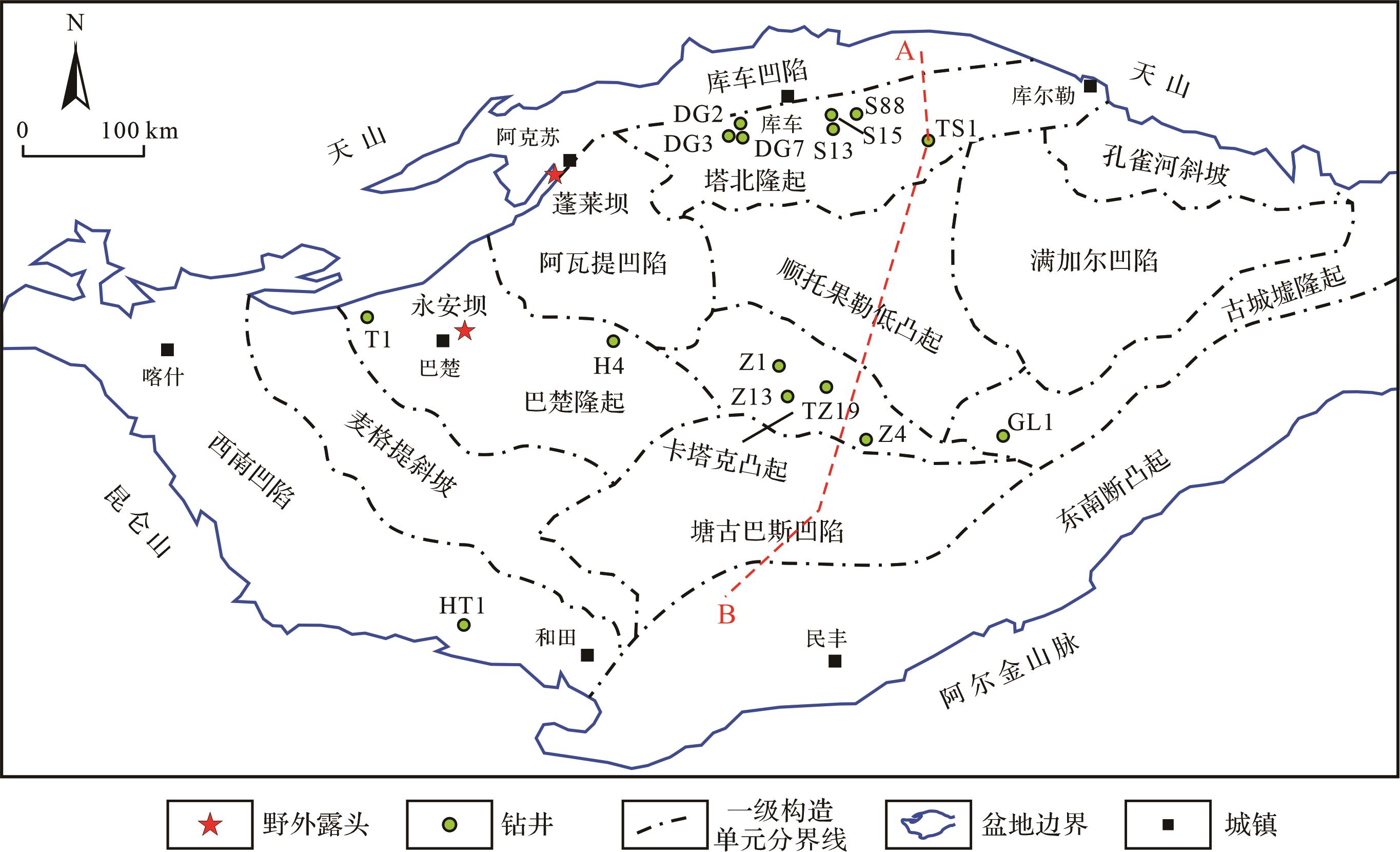-
白云岩的成因仍然存在很大争议[1⁃3],同时白云岩作为储层在碳酸盐岩油气勘探中具有非常重要的地位,其储集性能很大程度上受白云岩成因类型和结构特征影响[4]。近年来,国内白云岩储层中发现了多个大型(油)气田,如塔里木盆地、鄂尔多斯盆地苏里格气田、四川盆地普光—元坝及安岳大型或超大型气田等[5⁃6]。因此,对白云岩的结构类型及成因机理进行深入研究,不仅具有较大的理论意义,而且也将促进我国碳酸盐岩油气勘探取得更大的进展。
塔里木盆地作为重要的含油气盆地,勘探目标层位逐渐由中浅层转移到深层—超深层[5,7]。特别是下古生界深层白云岩中不断钻取工业油气流,使得该地区深层白云岩储层的形成、演化及储集特征等一系列问题成为研究的热点[8⁃16]。但由于这些白云岩的埋藏深、成因复杂、勘探难度大等特点[17⁃18],导致目前塔里木盆地寒武系—奥陶系白云岩的形成机制尚未达成统一的认识。因此,深入研究塔北、塔中及周边区域寒武系—奥陶系白云岩的结构类型和形成机理,探讨其成因联系,以期对塔里木盆地下古生界白云岩的油气勘探突破提供一定的理论支持。
-
塔里木盆地位于新疆维吾尔自治区南部(74°~91° E,36°~42° N),面积为56×104 km2,是我国最大的内陆盆地[18]。盆地位于天山和昆仑山之间,周边被一系列次级山系围绕(图1)。东南侧为阿尔金山,东北侧为库鲁克塔格山,西北侧柯坪塔格山,西南侧为铁克力克山。塔里木盆地由七个一级构造单元组成,自北向南依次为库车坳陷、塔北隆起、北部坳陷、中央隆起、塔西南坳陷、塔东南隆起和塔东南坳陷。其中北部坳陷包括阿瓦提凹陷、顺托果勒低凸起、满加尔凹陷;中央隆起带处于塔里木盆地中部,自西向东依次为巴楚隆起、卡塔克隆起、东南断隆起(图1,2)[19]。
研究区内,寒武系自下而上由玉尔吐斯组、肖尔布拉克组、吾松格尔组、沙依里克组、阿瓦塔格组及下丘里塔格群构成[18,21⁃22],它们主要形成在碳酸盐台地,其岩性主要为白云岩和少量灰岩、页岩及硅质岩(图3)。下奥陶统为蓬莱坝组,岩性主要为灰岩、白云岩(图3)。
-
白云岩样品取自塔北地区(钻井:DG2、DG3、DG7、S13、S15和S888)和塔中地区(钻井:Z1、Z4、Z13、T1、GL1和HT1)。在对研究区内白云石的精细分类基础之上,为了保证地球化学分析的准确性,利用微钻(最小直径1 mm)对各种类型白云石和灰岩进行精细取样。选定19个样品开展微量—稀土元素测试,65个样品开展碳、氧同位素测试,31个样品进行锶同位素比值测试。
微量—稀土元素测试在中国科学院地质与地球物理研究所微量元素地球化学分析实验室完成,称取40 mg粉末样品,采用HNO3+HF进行溶解,分析仪器为Finnigan MAT 公司 ELEMENT 型高分辨率等离子质谱仪。选用后太古宙澳大利亚页岩(Post Archean Australian Shale,PAAS)[23]对测试结果进行了标准化。δCe和δEu的计算公式分别为:δCe=CeN/ (LaN×PrN)1/2,δEu=EuN/(SmN×GdN)1/2,式中的下角标N代表标准化值。碳、氧同位素测试在中国科学院地质与地球物理研究所稳定同位素实验室完成,采用磷酸法制备CO2,分析仪器为MAT253质谱仪,测试结果采用VPDB标准,测试精度高于0.1‰。锶同位素测试在中国科学院地质与地球物理研究所固体同位素实验室完成,测试仪器为MAT262型质谱仪,测试结果误差(2σ)低于0.000 015。
-
以Gregg et al.[24]和Sibley et al.[25]白云石的分类方案为基础,根据白云石的产状,首先将白云石分为基质白云石和白云石胶结物[26]。再依据白云石的晶粒大小、晶面接触关系(平面、曲面)、晶形(自形、半自形、他形)等特征,进一步将基质白云石识别出6种白云石结构类型:(1)泥—粉晶基质白云石(Md1);(2)残余拟晶基质白云石(Md2);(3)粉—细晶、直面、自形—半自形、漂浮状基质白云石(Md3);(4)细—中晶、直面、自形—半自形基质白云石(Md4);(5)细—粗晶、曲面、他形基质白云石(Md5);(6)粗晶、曲面、鞍形基质白云石(Md6)。本文研究主要针对基质白云石,不涉及白云石胶结物。
-
这类白云石常构成灰白色或灰红色致密白云岩,其晶体直径小于0.05 mm,为泥晶—粉晶级,局部为极细晶;晶体形态以他形为主,少量半自形,晶体之间界限模糊。根据白云岩中是否与膏盐共生,可将其进一步分为与膏岩共生泥—粉晶白云石和泥—粉晶白云石两种亚类。
1) 与膏岩共生泥—粉晶白云石
这类白云石主要分布在中寒武统,由泥—粉晶白云岩与共生的硬石膏和石膏构成。此类白云石常呈纹层状、条带状;硬石膏主要以层状产出,单层厚度介于5~60 mm,与泥—粉晶白云岩呈互层产出(图4a),镜下呈针状、纤维状石膏假晶,长0.15~0.30 mm,具有一定的定向性。此外,可见白云岩砾屑包裹于硬石膏层之中(图4b);而石膏以层状或块状产出,镜下石膏晶体常呈等轴粒状或椭圆形(图4c),边缘不光滑有溶蚀痕迹,石膏晶体内部偶见柱状硬石膏(图4d),石膏晶体之间为泥晶白云石。
2) 泥—粉晶白云石
相比前一类型白云石,该类型白云石在区内更常见,其分布时代贯穿整个下古生界,其结构特征与上述含膏泥—粉晶白云岩中白云石的结构类似,但不含膏岩,且不与膏岩层共生,镜下岩性均一未见任何颗粒和交代残余。岩石呈浅灰—灰褐色,常呈薄层产出,常与藻凝块白云岩构成向上变浅的米级沉积旋回(图4e);显微镜下,可见白云石层与富泥质层构成水平纹层(图4f)。
-
这类白云石一般发育在富含生物骨架的白云岩中,白云岩一般为灰色—灰黑色,藻团块含量较高时一般为灰黑色。该类型白云石保留了原始灰岩的部分结构特征(图5a,b),其内常见的生物骨架包括藻(Renalcis、Epighyton及其他藻类)等。显微镜下,Md2的晶体主要为微—细晶,发育平面半自形或曲面半自形—他形结构(图5);藻团块的颜色通常为深灰色或灰黑色;阴极发光下,藻团块常呈暗红色,粒间孔胶结白云石常为红色(图5b,c)。残余拟晶白云石的孔隙类型主要为溶蚀孔或粒间孔,但大多数层位中这类白云岩的孔隙已被胶结(图5a,b)。
-
这类白云石常发育在部分白云石化的微晶灰岩中,其中灰岩一般为浅灰色,而白云岩斑块常呈深灰色(图6a)[26]。这种白云石常呈不规则的斑状或条带状沿低幅度的缝合线或压溶缝分布,其长轴常平行于缝合线及层面延伸方向(图6a)。显微镜下,这类白云石以粉—细晶、自形—半自形为主,呈漂浮状分散于基质之中,白云石晶体具有明显的雾心亮边结构(图6b);正交偏光下,白云石晶体表现出均匀的消光特征;阴极发光下,白云石晶体核心发暗淡的橙红光,边缘发较亮的橙光或橘红光。局部可见自形—半自形的细晶白云石漂浮于硅质胶结物之中,且部分白云石晶体表现出港湾状的边缘(图6c~f)。
-
这类白云石的手标本通常为灰色—褐灰色;单偏光下,白云石晶体以细晶为主,具直面、自形—半自形结构(图6g);可见晶粒大小不一的白云石晶体呈簇状分布,局部隐约可见缝合线的痕迹(图6h),且较大的白云石晶体常发育明显的雾心亮边结构;正交偏光下,白云石晶体表现出均匀的消光特征;阴极发光下,白云石晶体发光颜色为暗红色—橙红色,局部为褐红色。该类型白云石晶体之间见残余的灰泥,但孔隙相对较为发育,主要为晶间孔。部分孔隙可见油气充注,部分被后期方解石或白云石胶结物充填。在部分白云石化作用比较彻底的情况下,Md4表现出明显的“糖粒状结构”。此外,部分白云石晶体发生明显的曲面化(图6h)[26]。
-
这类白云石是研究区寒武系—奥陶系白云岩中最常见的结构类型,其手标本一般为灰色、浅灰色、灰白色。在显微镜下,白云石晶体的晶粒大小变化较大,以中—粗晶为主,局部为细晶(图7);白云石晶体常表现出曲面他形结构,晶面之间为镶嵌状接触(图7a~d);细—中晶白云石晶体发育较明显的雾心亮边结构(图7a),但粗晶表现出较污浊晶面、缺乏环带的特征(图7c,d);局部可见生物颗粒等交代残余的幻影结构。此外,高倍镜下中—粗晶白云石晶体中可见大量微小的矿物包裹体,但气液两相包裹体较少见。正交偏光下,白云石晶体表现出均匀的消光特征;阴极发光下,Md5晶体主要发暗淡的红光或斑状暗淡红光,其中细—中晶具雾心亮边的白云石晶体表现为中心不发光或暗淡红光、边缘发较亮的红光(图7b)。这类白云石的结构致密(图7a~d),仅局部发育零星的晶间孔稀少(图7b)。
-
这类白云石的发育常与断裂系统密切相关,且一般与鞍形白云石胶结物共生。显微镜下,白云石晶体常以粗晶为主,且晶面比较污浊;白云石晶体主要为曲面他形结构(图7e),常以曲面形式或缝合接触,局部可见半自形;部分粗大的白云石晶体内部发育大量的微裂缝(图7e);发育一定数量的气液两相包裹体,但其丰度不及伴生的鞍形白云石胶结物。正交偏光下,粗大的白云石晶体表现出明显的波状消光特征(图7f)。阴极发光下,鞍形白云石晶体不发光,或发斑状暗红色光,局部可见白云石晶体的边缘发明亮的红光。该类型白云石发育少量孔隙,主要为晶间孔和溶蚀孔。
-
塔里木盆地寒武系—奥陶系白云岩经历了十分复杂的埋藏成岩作用历史。基于前人研究成果,本文以缝合线(低振幅的压溶缝)出现的时间作为浅—中埋藏阶段的开始[27⁃28],以鞍形白云石出现之前的构造裂缝—溶蚀作用作为晚期(或深埋期)成岩作用的开始[29⁃30]。根据岩相学特征,可大致推测各成岩矿物的成岩序列如下(图8):方解石质的颗粒、生物格架和泥晶可视为同生期不同相带的原始沉积,在这类沉积物刚刚沉积后不久的准同生期,纤维状、片柱状方解石胶结物开始在颗粒间隙或生物格架孔隙内部沉淀[31]。同时,在潮上带的蒸发—浓缩作用下泥粉晶白云石(Md1)开始形成,伴随着表层富镁离子卤水的回流渗透,颗粒、生物格架等灰岩的原始结构组分逐渐被交代形成拟晶基质白云石(Md2)(详见第6部分)。随着沉积物继续堆积,早期的沉积物埋藏深度加大,逐渐脱离了海水环境,成岩流体开始发生变化,环境温度逐渐增加,孔隙中开始形成等轴粒状方解石胶结物,该类型胶结物一般出现在潜流带的成岩环境[31]。

图 8 塔北、塔中地区寒武系—奥陶系碳酸盐岩中共生矿物成岩序列
Figure 8. Paragenetic sequence of coexisting minerals of Cambrian⁃Lower Ordovician carbonates in northern and central Tarim Basin
灰泥埋深在500 m左右时开始出现压溶缝[27⁃28],其周围逐渐形成以自形—半自形结构为主的白云石集合体(Md3)。随着埋深的继续增加,灰泥中会形成更多的晶核并继续生长,灰泥逐渐溶解并形成自形—半自形白云石晶体。随着白云石化作用的持续进行,灰泥全部被交代形成相互连接的自形—半自形白云石晶簇(Md4),其内可见晶间孔发育,部分被烃类流体充注。当埋藏深度继续增加,这些自形白云石晶体之间开始发生化学压溶,并且随着环境温度的升高,晶面开始发生曲面化,形成细晶他形基质白云石(Md5-f)。同时伴随着晶体的溶解和重结晶,最终形成了较粗的曲面他形、镶嵌状的基质白云石(Md5-m-c)。伴随着这一溶解再沉淀的过程,黄铁矿可以富集。
他他形、曲面白云石形成以后,发生了一次比较广泛的构造劈裂—溶蚀作用,形成了与裂缝相连的晶洞,塔里木盆地白云岩地层进入一个新阶段,之后白云石胶结物(包括早期的直面、自形白云石胶结物和后期鞍形白云石胶结物)开始沉淀(图8)。紧随其后,石英或玛瑙状玉髓、黄铁矿、闪锌矿和黏土矿物开始出现。之后在残余孔洞或裂缝内形成方解石胶结物,这代表了后期流体的性质发生明显转变,可能与构造抬升,地层接近地表遭受大气淡水淋滤有关。但在野外发现柯坪、巴楚地区,在下古生界中发现有两组方解石脉发育,说明下古生界经历了两次构造抬升。在岩心观察中,由于资料和视野有限,不能对方解石胶结物(包括裂缝中的方解石)进行进一步区分。
-
本次样品稀土分析结果1显示,各种类型白云石的微量元素钪(Sc)和铀(U)的含量均较低。其中Sc的含量变化范围为(0.17~3.74)×10-6,平均值为1.40×10-6(样品数n=18);除了一个样品(YA-1)的U含量较高(13.71×10-6)外,其余样品的U含量变化范围为(0.15~3.28)×10-6,平均值为1.31×10-6(样品数n=17)。
整体来说,塔北地区和塔中地区各种类型白云石的稀土元素(Rare Earth Element,REE)总量(下文简称ΣREE)较为类似,均较低,整体介于(1.71~15.70)×10-6;同时,各种类型白云石整体表现为轻稀土(LREE)略微富集,重稀土(HREE)相对亏损。其中轻稀土整体介于(1.48~14.16)×10-6,平均值为6.31×10-6;重稀土整体介于(0.22~1.96)×10-6,平均值为0.78×10-6;LREE/HREE介于5.73~12.63,平均值为8.35。
标准化后的结果总体表现为Eu明显负异常,只有个别样品出现正异常(如TS1-1-6),δEu平均值为0.90;大多数样品Ce异常不明显,只有个别样品出现正异常或负异常,δCe平均值为0.93,这与塔里木盆地寒武系—奥陶系泥晶灰岩的稀土分配模式特征相似(图9)[32⁃33]。2个泥—粉晶白云石样品(Md1)的稀土分配模式图形态基本相同,轻稀土略微富集,Eu表现为明显的或轻微的负异常,Ce表现出轻微的负异常(图9b);2个残余拟晶基质白云石(Md2)的稀土分配模式图形态基本相同,轻稀土略微亏损,表现出微弱的Eu负异常和Ce负异常(图9c);4个细晶自形—半自白云石(Md4)的稀土分配模式图形态基本相同,轻稀土略微富集,表现出轻微的Eu负异常和轻微的Ce负异常或正异常(图9d);8个他形曲面白云石(Md5)的稀土分配模式图形态基本相同,轻稀土略富集,表现出轻微的Eu正异常或负异常、轻微的Ce正异常或负异常(图9e);3个鞍形基质白云石(Md6)的稀土分配模式图略有差别,其中两个形态基本相同,轻稀土相对亏损,表现出明显的或轻微的Eu负异常,而另一个样品表现出明显的Eu正异常(图9f)。
-
对塔北地区和塔中地区65个样品碳、氧同位素测试数据①的分析发现,研究区不同类型成岩矿物间的氧、碳同位素值之间通常会有重叠(图10)。塔北地区一个泥晶藻灰岩的δ13C值为1.33‰,δ18O值为-7.67‰;1个残余拟晶基质白云石的δ13C值为-1.19‰,δ18O值为-5.51‰;细晶自形—半自形基质白云石的δ13C值介于-1.71‰~-0.84‰,平均值为-1.31‰(样品数:n=4),δ18O值介于-8.96‰~-5.35‰,平均值为-6.46‰;中晶自形—半自形基质白云石的δ13C值介于-2.07‰~-1.71‰,平均值为-1.89‰(样品数n=2),δ18O值介于-5.63‰~-5.41‰,平均值为-5.52‰;细晶他形曲面基质白云石的δ13C值介于-2.04‰~-0.81‰,平均值为-1.37‰(样品数n=7),δ18O值介于-8.98‰~-5.51‰,平均值为-6.93‰;中粗晶他形曲面基质白云石的δ13C值介于-2.40‰~-1.28‰,平均值为-1.97‰(样品数n=7),δ18O值介于-6.63‰~-5.08‰,平均值为-5.66‰。

图 10 塔北地区(a)和塔中地区(b)寒武系—奥陶系泥晶灰岩与白云岩δ13C⁃δ18O交会图
Figure 10. Cross⁃plot of δ13C and δ18O values for limestone and different types of matrix dolomites in (a) northern Tarim Basin; and (b) central Tarim Basin
塔中地区泥晶灰岩样品的δ13C值介于0.60‰~1.35‰,平均值为0.92‰(样品数n=4),δ18O值介于-6.39‰~-5.08‰,平均值为-5.58‰;1个残余拟晶基质白云石的δ13C值为-2.21‰,δ18O值为-6.51‰;细晶自形—半自形、漂浮状白云石的δ13C值为-2.02‰~-2.00‰,平均值为-2.01‰(样品数n=2),δ18O值为-5.88‰~-5.20‰,平均值为-5.30‰;细晶自形—半自形基质白云石的δ13C值介于-2.45‰~1.72‰,平均值为-0.53‰(样品数n=5),δ18O值介于-5.66‰~-5.09‰,平均值为-5.30‰;中晶自形—半自形基质白云石的δ13C值介于-2.06‰~-1.62‰,平均值为-1.91‰(样品数n=4),δ18O值介于-7.96‰~-7.19‰,平均值为-7.59‰;细晶他形曲面基质白云石的δ13C值介于-2.83‰~-1.18‰,平均值为-2.13‰(样品数n=11),δ18O值介于-8.98‰~-5.36‰,平均值为-6.35‰;中—粗晶他形曲面基质白云石的δ13C值介于-2.03‰~-1.08‰,平均值为-1.62‰(样品数n=9),δ18O值介于-8.49‰~-5.05‰,平均值为-6.90‰;粗晶鞍形基质白云石的δ13C值介于-1.65‰~-1.33‰,平均值为-1.48‰(样品数n=7),δ18O值介于-7.13‰~-5.28‰,平均值为-6.35‰。
-
通过对塔北地区和塔中地区31个样品Sr同位素测试数据2的分析发现,泥微晶灰岩与不同类型基质白云石的87Sr/86Sr值变化范围有重叠(图11),这与它们的碳、氧同位素特征相似(图10)。塔北地区1个泥晶藻灰岩的87Sr/86Sr值为0.710 572;1个残余拟晶藻白云石的87Sr/86Sr值为0.709 206;细晶自形—半自形基质白云石的87Sr/86Sr值介于0.708 9~0.709 4,平均值为0.709 3(样品数n=3);细晶他形曲面基质白云石的87Sr/86Sr值介于0.709 1~0.709 6,平均值为0.709 2(样品数n=4);中晶他形曲面基质白云石的87Sr/86Sr值介于0.709 2~0.710 3,平均值为0.709 7(样品数n=2)。

图 11 塔北地区(a)和塔中地区(b)寒武—奥陶系泥晶灰岩与白云岩Sr87/Sr86⁃δ18O交汇图
Figure 11. Cross⁃plot of 87Sr/86Sr and δ18O data for limestone and different types of matrix dolomites in (a) northern Tarim Basin; and (b) central Tarim Basin
塔中地区1个泥晶灰岩的87Sr/86Sr值为0.708 513;细晶自形—半自形基质白云石的87Sr/86Sr值介于0.709 7~0.710 3,平均值为0.710 1(样品数n=3);中晶自形—半自形基质白云石的87Sr/86Sr值介于0.709 1~0.711 6,平均值为0.710 2(样品数n=4);细晶他形曲面基质白云石的87Sr/86Sr值介于0.709 0~0.709 1,平均值为0.709 1(样品数n=3);中—粗晶他形曲面基质白云石的87Sr/86Sr值介于0.709 0~0.709 9,平均值为0.709 2(样品数n=7);粗晶鞍形基质白云石的87Sr/86Sr值介于0.708 7~0.709 2,平均值为0.709 0(样品数n=2)。
-
碳酸盐岩的稀土元素地球化学特征通常被用来探讨碳酸盐岩成岩作用过程中的水岩反应(如白云石化流体的来源和特征)和古海洋的REE特征[38⁃40]。但碳酸盐岩的REE含量和配分模式会受非碳酸盐物质(如陆源碎屑物质、硫化物等)和成岩作用的影响,从而导致数据不能有效地反映白云石化流体的性质[39⁃40]。因此,在利用碳酸盐岩的REE示踪白云石化流体来源和探讨白云石化作用模式之前,应先评估REE数据的可靠性。
陆源碎屑物质(如页岩)是碳酸盐岩REE的一个主要污染源,页岩中锆(Zr)元素含量较高(PAAS中Zr含量可达210×10-6),而低温水体中Zr含量非常低,因此Zr可以作为表征陆源碎屑物质污染的有效手段[38,41]。研究区寒武系—奥陶系白云岩的Zr-∑REE协变图(图12a)显示,它们的Zr含量与∑REE相关性较好,说明研究区寒武系—奥陶系白云岩的REE特征受到较为强烈的陆源碎屑污染。另一方面,由于钪(Sc)元素常在硫化物中富集,因此可利用Sc元素来示踪硫化物对碳酸盐岩REE特征的影响[38,42]。研究区寒武系—奥陶系白云岩的Sc-∑REE协变图(图12b)显示,它们的Sc含量与∑REE不具相关性,指示研究区寒武系—奥陶系白云岩的REE特征未受硫化物的影响。此外,成岩作用过程可造成碳酸盐岩中Ce含量的增加和DyN/SmN比值的降低,从而造成δCe与DyN/SmN之间的负相关和DyN/SmN与∑REE之间的正相关[42⁃43]。研究区寒武系—奥陶系白云岩的δCe与DyN/SmN和DyN/SmN与∑REE之间均不具相关性,表明它们的REE特征受成岩作用的影响微弱。
-
塔北、塔中地区寒武系—奥陶系不同类型白云石的岩相学和地球化学特征显示,研究区寒武系—奥陶系白云岩主要形成于同生—准同生白云石化作用(萨布哈白云石化作用和回流渗透白云石化模式)、埋藏白云石化作用(浅—中埋藏白云石化作用和深埋藏白云石化作用)及构造—热液白云石化作用。
-
1) 岩相学证据
研究区Md1常与硬石膏、干裂构造等干燥气候下的潮缘环境沉积特征共生,局部发育的微波状—水平纹层构造(图4),说明其形成于盐化的潮坪环境[3],而且泥粉晶晶体说明其形成环境温度较低[12,44⁃45]。以上特征表明Md1形成于强烈蒸发的盐化潮坪环境,类似于波斯湾的萨布哈潮上带[45]。
2) 地球化学证据
陈永权等[32⁃33]报道的塔里木盆地寒武—奥陶系泥微晶灰岩或含云灰岩的∑REE为(1.69~6.81)×10-6,轻稀土略微富集,Ce和Eu均表现出轻微的正异常或负异常,这些特征与受非碳酸盐物质影响的碳酸盐岩类似,而与现代海相碳酸盐岩的稀土配分模式(如轻稀土亏损、La的正异常、Gd的正异常和Ce的负异常[46])存在明显不同,表明研究区寒武系—奥陶系泥微晶灰岩或含云灰岩的REE特征受到非碳酸盐矿物的影响[31,47]。Md1的∑REE变化范围和稀土配分模式与塔里木盆地寒武系—奥陶系泥晶灰岩稀土元素含及配分模式类似(图9a,b),表明Md1的成岩流体主要为不同程度蒸发浓缩的海水[9,47]。
3) 成因模式
寒武纪—早奥陶世时期,塔里木盆地位于赤道附近,气候以温暖、半干旱—干旱为主[48]。在该气候背景下,强烈的蒸发作用使得潮上带表层碳酸盐沉积物中孔隙水不断浓缩,石膏首先发生沉淀,而使粒间水或表层积水的Mg2+/Ca2+比率大大提高,硫酸根离子浓度降低,其毒化作用大大消减[49⁃50],有助于克服白云石形成的动力学障碍[3]。由于盐度差和毛细管作用,下部海水可以源源不断的被泵吸至表层,最终导致表层碳酸盐沉积物完全白云化。另一方面,高潮期或风暴潮汐强烈时期,涌入潮上带的海水在重力作用下也会通过松散的沉积物下渗(图13),从而为孔隙流体源源不断的提供镁离子[3,51]。一些研究表明,细菌的存在(或细菌硫酸盐还原作用,BSR)也是促进白云石化作用的一个重要条件,它们在白云石化作用过程中发挥着重要的作用[12,44,52⁃54]。
-
1) 岩相学证据
Md2的藻黏结结构指示其发育在一个相对低能的局限环境[31]。这类白云石晶体的晶粒主要为微—细晶,且以平面半自形或曲面半自形—他形结构为主,表明这类白云石形成于相对低温的同生—准同生白云石化作用[2⁃3,24⁃25]。因此,Md2主要形成于相对低能局限环境的同生—准同生白云石化作用。
2) 地球化学证据
Md2的∑REE变化范围和稀土配分模式与塔里木盆地寒武系—奥陶系泥晶灰岩类似,但配分模式存在一定差异,且与朱东亚等[34]报道的塔北地区S15井粉—细晶白云岩(石)的稀土含量和配分模式类似(图9a,c,g),说明Md2的REE特征受陆源碎屑物质的影响较Md1小,且其成岩流体主要为海源流体(主要为同时期海水)[9,47]。塔北地区这类白云石的δ13C值和87Sr/86Sr值与塔中地区相当,且与同时代泥微晶灰岩或亮晶方解石胶结物[9]和同时期海水(δ13C介于-2.5‰~1.5‰;87Sr/86Sr介于0.708 6~0.709 6[12,36⁃37])类似,也表明塔北和塔中地区Md2的形成流体均为同时期海水。需要注意的是,塔北地区这类白云石较低的δ13C值可能受到有机来源低碳(12C)的影响[50]。
3) 成因模式
在相对局限的台地内部(如潟湖),由于其中的水体与开阔海的循环受限,蒸发作用会造成其内的水体盐度一定程度的升高。但Md2内未见蒸发岩类(如石膏等)的发育,说明其形成时,其成岩流体的浓度仍低于石膏的饱和度,即潟湖内主要为中盐度—近咸化海水(mesosaline to penesaline seawater)[11,51,54]。细粒沉积物可为初始白云石(种晶,seed crystals)提供大量的成核点,有利于白云石晶体的沉淀[3]。由于潟湖内海水的密度比下伏孔隙水高,这种蒸发浓缩的海水会渗透过下伏的沉积物(即回流渗透[51,55])。在低温环境下生物骨架的交代作用可以缓慢进行,其原生结构可得以保存[2],这样便形成了Md2。这与前人对塔里木盆地寒武系—奥陶系具生物结构白云岩(石)的成因认识是一致的[50,56⁃57]。
-
1) 岩相学证据
Md3常与低振幅缝合线共生,说明其形成与缝合线的形成过程密切相关[11⁃12,58]。Md3和Md4的自形—半自形晶体结构均表明它们形成在浅埋藏环境,此时地温低于白云石生长的临界糙面温度(critical roughening temperature,介于50 ℃~60 ℃ [24⁃25])。
2) 地球化学证据
Md4的∑REE变化范围和稀土配分模式也与塔里木盆地寒武系—奥陶系泥晶灰岩稀土元素含量及配分模式类似(图9a,d),说明Md4的成岩流体主要为海源流体[9,47]。整体来看,塔中地区的Md3和两个地区的Md4的δ13C和87Sr/86Sr比值范围与Guo et al.[12]报道的塔北地区上寒武统—下奥陶统同类型白云石的δ13C(-2.30‰~-1.10‰;平均值为-1.90‰)和87Sr/86Sr(0.709 1~0.709 3;平均值为0.709 2)与Guo et al.[11]报道的塔西露头地区下奥陶统同类型白云石的δ13C(-2.30‰~-1.40‰;平均值为-1.90‰)和87Sr/86Sr(0.709 1~0.709 3;平均值为0.709 2)类似,同时这两类白云石的δ13C值和87Sr/86Sr值与同时代泥微晶灰岩或亮晶方解石胶结物[9]和同时期海水[12,36⁃37]基本相当,也表明Md3和Md4的形成流体为海源流体。中晶Md4的87Sr/86Sr值高于同时期泥微晶灰岩或亮晶方解石胶结物和海水,可能是因为受到陆源物质或重结晶作用的影响[29⁃30,58]。
3) 成因模式
前人研究表明,低振幅缝合线形成的埋藏深度一般大于500 m[27⁃28]。假设地表年平均温度为20 ℃,考虑到塔里木盆地古生代地温梯度为30~35 ℃/km[59⁃60],那么Md3的形成时间主要为晚奥陶世—志留纪,此时寒武系—下奥陶统地层埋深大概为500~1 000 m(图14)。在浅埋藏环境,上覆沉积物的压实作用会导致压溶作用的发生,可促进富泥质灰岩中镁离子的释放,有利于提高孔隙水中的镁离子浓度[65⁃66],有助于Md3的形成。另一方面,细粒沉积物也可为初始白云石提供大量的成核点,也有利于白云石晶体的形成[3]。当白云石化流体补充不足时,将会发生部分白云石化作用,形成漂浮状的Md3[11⁃12]。若白云石化流体充足,可将流经的灰岩完全交代形成Md4。随着埋深的增加,地层温度和压力均会升高,先期形成的Md4晶体会发生竞争性的生长,形成花瓣状的白云石晶体(图6h)[2]。
-
1) 岩相学证据
与上述几种基质白云石相比,Md5白云石晶体晶粒更加粗大,晶面更加曲面化且呈镶嵌状接触(图7a~d),表明Md5的形成温度更高、生长的速度更快[24⁃25],揭示Md5形成于更大的埋藏深度。前人研究显示,更粗大的白云石晶体和嵌晶结构可能形成于细晶Md5的晶体增生和聚合[12,58]。
2) 地球化学证据
Md5的∑REE变化范围和稀土配分模式也与塔里木盆地寒武系—奥陶系泥晶灰岩稀土元素含量及配分模式基本类似(图9a,e),且与朱东亚等[34]报道的塔北地区S15井中—粗晶白云岩(石)的稀土含量和配分模式类似,表明Md5主要形成于海源流体[9,47]。整体来看,塔北地区Md5的δ13C和87Sr/86Sr比值范围,与Guo et al.[12]报道的塔北地区上寒武统—下奥陶统同类型白云石的δ13C和87Sr/86Sr比值及Guo et al.[11]报道的塔西露头地区下奥陶统同类型白云石的δ13C和87Sr/86Sr比值类似。同时,这类白云石的δ13C值和87Sr/86Sr值与同时代泥微晶灰岩或亮晶方解石胶结物[9]和同时期海水[12,36⁃37]类似,也指示Md5的形成流体为海源流体(即地层中封存的海源孔隙水)。
3) 成因模式
Md5作为研究区最为常见的一种白云石类型。随着埋深的增加,地层温度和压力均升高,且地层温度超过临界糙面温度(50 ℃~60 ℃[24⁃25]),此时白云石晶体的持续生长便形成Md5。除此之外,当白云石生长的环境受到异常热源(如深部热流体)的影响时,也可加速白云石晶体的增生和曲面化,从而形成Md5。在这种情况下,先期形成的白云石会发生重结晶作用,也可形成粗大的Md5。另一方面,考虑到中深埋藏阶段孔隙水难以提供大量的镁离子来源,Md5可能主要来自先期形成白云石的重结晶作用[11⁃12,30]。
-
1) 岩相学证据
粗大的白云石晶体和曲面他形结构(图7e,f)表明其形成在高于临界糙面温度的环境[24⁃25]。卿海若等[67]对加拿大萨斯喀彻温省东南部上奥陶统Yeoman组碳酸盐岩中鞍形白云石胶结物的岩石学和地球化学开展研究,认为这类鞍形白云石胶结物主要形成于相对封闭体系中早期交代白云石的自调节白云石化作用。但研究区鞍形白云石常与断裂系统和鞍形白云石胶结物共生,说明其形成与构造热液活动有关,并非封闭体系中白云石的自调节作用。
2) 地球化学证据
Md6的∑REE变化范围和稀土配分模式也与塔里木盆地寒武系—奥陶系泥晶灰岩和Md5类似(图9a,e,f),指示Md6的成岩流体与上述基质白云石类似。但塔北地区Md6稀土配分模式中Eu表现是明显的正异常,说明塔北地区Md6形成过程中受到热液活动的作用[40⁃41]。塔中地区Md6的δ13C和87Sr/86Sr比值范围与上述基质白云石、同时代泥微晶灰岩或亮晶方解石胶结物[9]及同时期海水(δ13C:-2.5‰~1.5‰;87Sr/86Sr:0.708 6~0.709 6[12,36⁃37])类似,也表明Md6形成于与它们类似的成岩流体。此外,Md6的δ13C和δ18O与塔北地区上寒武统—下奥陶统白云岩内鞍形白云石的δ13C(-1.70‰~-0.70‰,平均值为-1.10‰)和δ18O(-8.90‰~-5.60‰;平均值为-7.50%)、87Sr/86Sr范围(0.708 5~0.709 0;平均值为0.708 8)[12]和研究区寒武系—奥陶系碳酸盐岩中鞍形白云石胶结物的δ13C(-2.45‰~-0.69‰)和δ18O(-9.10‰~-5.12‰)、87Sr/86Sr范围(0.708 6~0.710 2)[16]相当,指示塔中地区Md6的成岩流体与塔北地区上寒武统—下奥陶统白云岩内鞍形白云石类似。Guo et al.[12]将塔北地区上寒武统—下奥陶统白云岩内鞍形白云石的成岩流体解释为与二叠纪火山岩省有关的热液流体,这类流体在沿裂缝向上运移的过程中与宿主围岩强烈反应,获得了与宿主围岩类似的δ13C和87Sr/86Sr特征;王丹等[16]依据研究区鞍形白云石胶结物的87Sr/86Sr特征(低于世界范围内其他盆地鞍形白云石),认为研究区鞍形白云石成岩流体主要为深部热液,未经过碎屑疏导层的长距离运移。结合研究区Md6的岩石学、地球化学特征,将Md6的成岩流体解释为深部热液流体。
3) 成因模式
前人研究显示,塔里木盆地热液白云石化作用与海西晚期的火山热液活动密切相关[12,18,50,58,68],后者可形成一系列的断裂系统(图15)。在热动力驱动下,热液流体流经高孔渗的断裂带时,会引起先期形成白云石的溶蚀作用和重结晶作用。该过程中,强烈的水岩反应使得热液流体具备与基质白云石类似的δ13C和87Sr/86Sr,从而形成具有与基质白云石类似地球化学特征的鞍形基质白云石(Md6)。另一方面,这种对白云石过饱和的热液流体沿断裂系统向上运移过程中,还可能交代周围的灰岩形成鞍形基质白云石(Md6)(图15)。整体来说,塔里木盆地寒武系—奥陶系鞍形白云石碳氧锶同位素携带了宿主白云岩(石)的信息,是一种特殊的热液白云石化作用(hydrothermal cannibalized dolomitization,称之为“热液调节白云石化作用”)。
-
(1) 基于国际学术界通用的白云石分类方法,将塔北、塔中地区寒武系—奥陶系基质白云岩划分为6种类型:①泥—粉晶基质白云石(Md1);②残余拟晶基质白云石(Md2);③粉—细晶、直面、自形—半自形、漂浮状基质白云石(Md3);④细晶、直面、自形—半自形基质白云石(Md4);⑤细—粗晶、曲面、他形基质白云石(Md5);⑥粗晶、曲面、鞍形基质白云石(Md6)。
(2) Md1~Md5的稀土配分模式、δ13C和87Sr/86Sr与寒武系—奥陶系泥微晶灰岩及同时期海水具有类似的特征,表明它们的成岩流体均为海源流体。与断裂系统密切相关的关系和与其他类型基质白云石类似的地球化学特征,指示Md6可能形成于与宿主白云岩发生强烈水岩反应的深部热液。
(3) 研究区寒武系—奥陶系白云岩主要形成于同生—准同生白云石化作用(包括萨布哈白云石化作用和回流渗透白云石化模式)、埋藏白云石化作用(包括浅—中埋藏白云石化作用和深埋藏白云石化作用)、构造—热液调节白云石化作用。
全文HTML
3.1. 泥—粉晶白云石(Md1)
3.2. 残余拟晶基质白云石(Md2)
3.3. 粉—细晶、直面、自形—半自形、漂浮状基质白云石(Md3)
3.4. 细—中晶、直面、自形—半自形基质白云石(Md4)
3.5. 细—粗晶、曲面、他形基质白云石(Md5)
3.6. 粗晶、曲面、鞍形基质白云石(Md6)
5.1. 微量—稀土元素
5.2. 碳氧同位素(δ13C和δ18O)
5.3. 锶同位素比值(87Sr/86Sr)
6.1. 数据有效性评价
6.2. 白云岩的形成机制
6.2.1. Md1的形成机制
6.2.2. Md2的形成机制
6.2.3. Md3和Md4的形成机制
6.2.4. Md5的形成机制
6.2.5. Md6的形成机制
 王丹附表.rar
王丹附表.rar
|

|




 下载:
下载:
















